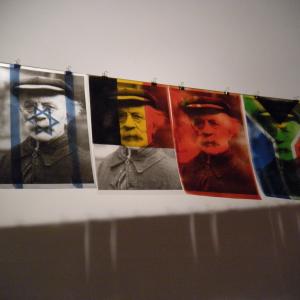Margherita Morgantin - Enzo Umbaca
video-installation-painting-drawing
curator Roberto Pinto
venissage Nov.11th 2010 from 19,30
rue des Chevaliers ixelles-1050 Bruxxelles
CREDIT/Partnership
MIAT Museum of Industrial Archaeology and Textile Gent- Minnemeers9 9000GENT www.miat.gent.be
Special Thanks
Georgeanne Kalweit musician-Ann Van Nieuwenhuyse director Museum’s staff–Momo NTGNT Theatre Gent -Alessandro Fazio Brussels-Franco Soffiantino Gallery Torino- Pinto Belga Queen /historical bank/ restaurant Brussels –Monique Moncorger – Françoise Van Den Bempt - Etlalumièrefut Philipe Ambrozy BR-BE __________________________________________________
info/contact
rosa anna musumeci info@artecontemporaneact.com
+32 (0)496 67 33 16 +32 330692388
opened: Tu.-Fr. H 11,00-14,00 16,00 20,00
o per appuntamento
www.artecontemporaneact.com www,arteesud.it
Skype arecontemporanea facebook artecontemporaneabruxelles.gmail.com
European education (Short Text version)
In planning an exhibition, the curator may be tempted to invite artists sharing the same medium - e.g. photography or painting – or a common topic. By these criteria, bringing together Margherita Morgantin and Enzo Umbaca would amount to little more than a pretext. This notwithstanding, I think that joining their projects and works is fully justified and justifiable. First of all, one can easily perceive much the same spirit, an affinity reaching well beyond the occasional pairing of media and topics. This affinity springs out of a vision of society both careful and critical, which pushes the artists to focus on less than spectacular facets of real life. Under closer scrutiny, though, these facets symbolically embody the contradictions of our times.
Their works might be dubbed ‘political’ – admittedly a word carrying a derogatory, or at best a rhetorical, bias, in the Italian context particularly. At any rate, I do say political since their reading of reality aims at probing the social side-effects of rules, choices, customs, or ways of thinking. Though critically, a dialogue is thus entertained with the environment…On the other hand, the divide is probably the different, indeed almost opposite, treatment of the works’ relational facets. Enzo Umbaca often seems to start from his own intuitions/ideas, and lets them change as others step in and because of the works’ building tools themselves… The relationship to others (Deleuze’s and Guattari’s intercessors, or mediators) is equally crucial for Margherita Morgantin, though (at odds with Umbaca) it seems to work beforehand. Written sources, contacts, movies, everyday events, discussions, and, last but not least, a scientific reading of society, may be the starting cues, providing a crucial common environment. But Morgantin’s creative process truly unfolds through an individual, almost solitary, elaboration of those elements…Otherwise put, Umbaca involves us into a relationship, whereas Morgantin drives us toward a vision of reality mediated by her own eyes. I have often been feeling that Margherita’s works were to be read like a book; on the other hand, Umbaca calls for participating (though seldom by performance actions)…
The works have been conceived with an eye to the centrality of the exhibition’s space, an Italian gallery placed in the very hearth of Brussels and its European institutions. Obviously enough, the aim is to meditate over societal contradictions, our being Europeans and the related meaning(s). An European education as ironically evoked by the touching novel of Romain Gary has perhaps yet to materialize; though the World War II bleak times lived by his protagonists are over, I maintain that writing, composing music, creating artworks are crucial shelters, hideouts for taking care of “all what prevents men from falling into despair and allow them to believe in something and keep alive”.
Umbaca draws attention on the worker/musician Peter De Geyter, the composer of the Internationale. His video shows a musician playing backwards the worldwide most celebrated hymn in front of De Geyter’s monument at Gent. The work’s title – Once Upon a Time: The Internationale - is partly a denunciation of the tiny room left for utopia and human brotherhood in the very core of trans-national EU institutions; on the other hand, the underlying ideologies and their historical failures are emphasized and denied any chance of nostalgic comeback. These topics are also stressed by an installation – Ready Listening - whereby the version of the socialist hymn recorded during the performance is played on a vinyl disc turned by a drill. The more the hymn is played, the more it deteriorates, up to self-destruction. Symbols of work and of the undergoing changes are thus made explicit and revived to return an expression both synthetic and effective of the passing by of time and the ideas it nurtured.
In turn, Margherita Morgantin shows a rectangular assemblage of workers’ safety helmets. They are blue like the EU flag, and are topped by twelve red stars of explicit Chinese coinage. The emphasis is on the short-circuiting of ideals and economic interests, of human rights and work’s exploitation, of democracy and the globalization process. This ambiguous, multil
Roberto Pinto











Comments 2
Say something